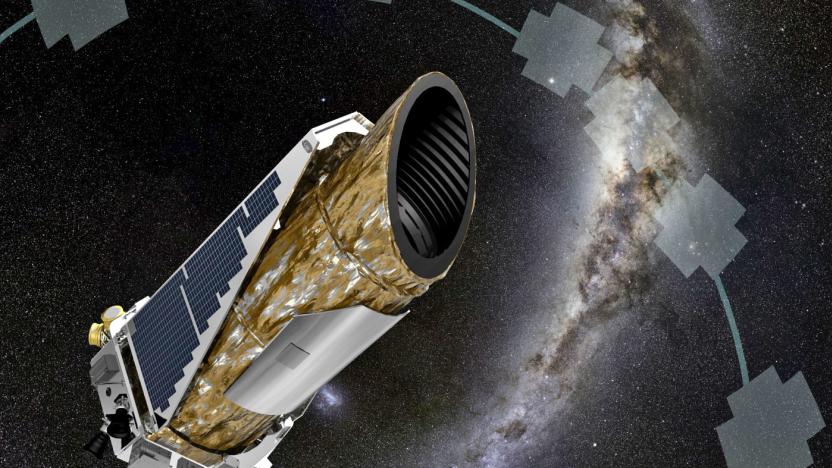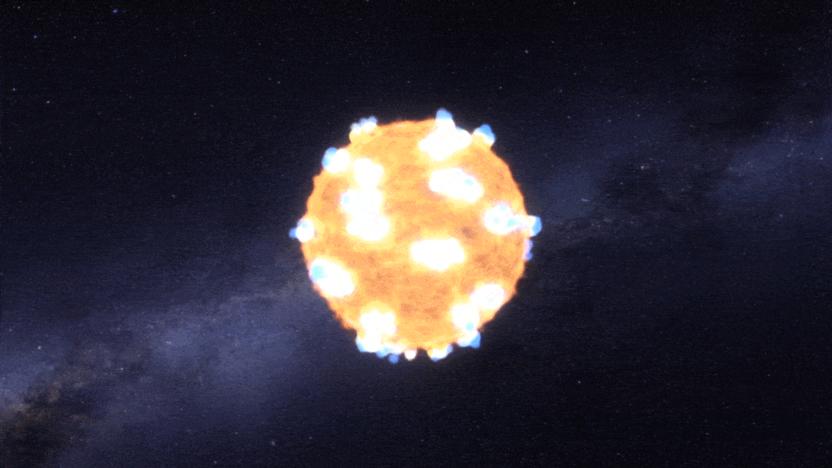KeplerTelescope
Latest

Newborn exoplanet might be the youngest ever observed
NASA's planet-hunting Kepler space telescope has made another interesting cosmic discovery, the space agency reports this week. The youngest, fully formed exoplanet ever observed has been spotted just 500 light-years from Earth in the K2–33 star system. The star is a mere 5 million to 10 million years old, meaning the planet, lovingly dubbed K2–33b, is about the same age and practically a baby on the cosmic scale.

NASA's Kepler spacecraft is in 'emergency mode'
NASA's Kepler space telescope was supposed to be continuing its K2 extended mission to hunt down hidden exoplanets, but now scientists say the spacecraft is in trouble (again). While trying to make regularly scheduled contact on Thursday engineers found that it is operating in "emergency mode" and are focused on trying to recover it. That's a bit tricky however, since it's almost 75 million miles away from Earth, and it takes 13 minutes for signals to make a round trip.

NASA catches the flash of a supernova for the first time
Spotting supernovae is relatively easy, but witnessing the immediate aftermath of those exploding stars? That's hard -- however, NASA has managed just that. By using the Kepler space telescope to capture the light of 500 galaxy every 30 minutes for 3 years, the agency caught the flash of a supernova's initial shockwave as a red supergiant (KSN 2011d) met its grisly end. That's no mean feat when this early burst only lasted roughly 20 minutes, and the target star was a whopping 1.2 billion light years away.

The majority of Earth-like planets haven't been born yet
Humanity's inability to find Earth-like planets may not be the result of limited technology or a lack of ambition -- we might simply be too early, and in the wrong place. Astronomers poring over Hubble and Kepler data now believe that only 8 percent of the universe's potentially habitable planets exist. Based on the amount of hydrogen and helium gas left over from the Big Bang, there's still plenty of opportunity for those planets to form. These planets are most likely to appear in either dwarf galaxies or giant galaxy clusters, where the stars haven't used up all the surrounding gas.

NASA finds Earth-sized planet that could support life
NASA's Kepler telescope has discovered a veritable bounty of alien planets, but none of them have been quite like Earth -- until now. Today, the agency announced that Kepler-186f is the first confirmed Earth-sized planet in the habitable zone of another star. In other words, it's the right size and distance from its sun to have properties similar to our planet -- namely, a rocky composition and liquid water on its surface.

NASA's Kepler telescope spies smallest planet to date, no aliens
NASA's Kepler telescope is permanently on the lookout for celestial objects of interest, and its latest discovery is a small one. A small planet, to be exact -- in fact, the smallest its encountered during its search. Kepler-37b is a tad larger than our heavenly dance partner, the Moon, and whizzes round a star much like our Sun, with two larger planets in its system for company. NASA's issuing back pats all round, as finding Kepler-37b has highlighted "the precision of the Kepler instrument" (although admittedly, the star's behavior was favorable), and suggests there are many more humble worlds of similar size awaiting our detection. It's unlikely any aliens call Kepler-37b home: it's thought to be rocky, with no atmosphere, and hugs its sun in a 13-day orbit cycle, meaning surface temperature is terribly high. Still, an achievement for Kepler, no doubt, but what we really want it to find is a planet home to beings who can explain the plot-line of Prometheus. We're still a little confused.

The new stars of reggae are nothing like the old ones
Earthly music just ain't enough for reggae / rock band Echo Movement. In search of extraterrestrial inspiration, they hooked up with researchers at Georgia Tech's Sonification Lab, which specializes in turning ugly numbers into beautiful music. Using data from NASA's Kepler telescope and its search for Earth II, SonLab generated "sequences of sonified musical pitches" from fluctuations in a star's brightness (meet Kepler 4665989). Echo Movement got their loop on and composed a harmony from the sequences, adding a tremolo effect from another star's pattern for a softer sound. Unfortunately, the finished track isn't out til September, but in the meantime you can hear the six-second celestial hook at the source link -- just don't blame us if you get pangs of Nokia-stalgia. Also, if you want to imagine how Echo Movement might use the sample, we've embedded one of their rarer songs -- that doesn't involve Spider-Man's girlfriend -- after the break.

Visualized: 1,235 potential alien planets
The tiny black dots set against their glowing host stars above represent 1,235 potential alien planets discovered by NASA's Kepler mission. With any luck, at least one of them has never heard of Justin Bieber.



